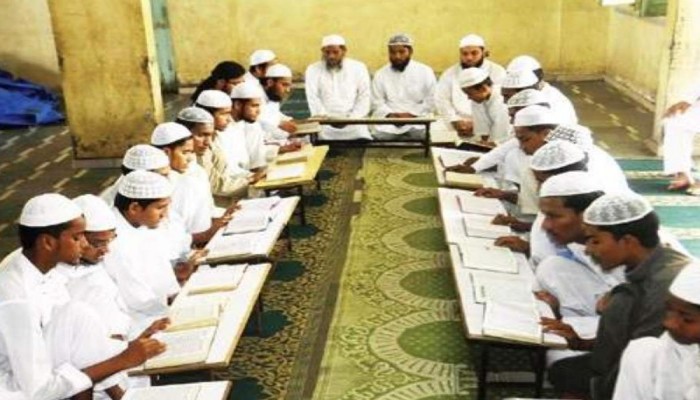Abolition of State-Run Madrassas in Assam: A Much-Needed Move to Tackle Islamic Radicalisation
- In Politics
- 10:57 AM, Feb 08, 2021
- Ankita Dutta
The Government of Assam has recently enforced the ‘Assam Repealing Act’ to abolish all state-run madrassas, following which 620 such schools will be converted into general schools from April 1, 2021 onwards. A law to this effect was passed by the Assam Legislative Assembly on December 30, 2020 which later received the assent of Assam Governor Prof. Jagdish Mukhi. In this context, the Assam Repealing Act, 2020 was passed to abolish the Assam Madrassa Education (Provincialisation) Act, 1995 and the Assam Madrassa Education (Provincialisation of Services of Employees and Re-organisation of Madrassa Educational Institutions) Act, 2018. The decision was announced by Assam Education and Finance Minister Dr. Himanta Biswa Sarma on February 03, 2021. However, a decision on the hundreds of privately-run madrassas across Assam is yet to be taken by the government.
Much predictably, opposition parties, including the Congress and its alliance partner the All India United Democratic Front (AIUDF), had staged a vehement word of protest against the passage of the Bill in the Assembly. They have argued that it stands against the basic constitutional principles of “secularism” and “equality” as enshrined in the Constitution of India. The All Assam Minority Students’ Union too, has said that the decision to shut down madrassas is in line with the BJP Government’s agenda of “harassing Muslims and denying them basic rights” as guaranteed by the Constitution.
Following the enforcement of the Act, the State Madrassa Education Board in Assam would also be disbanded. Himanta Biswa Sarma had earlier informed that the Govt. of Assam had been spending a huge sum of Rs. 260 crores annually for running the madrassas exclusively, and that “the government cannot spend public money for religious teachings anymore”. It was in early December, 2020 that the State Cabinet had approved a proposal to shut down all government-run madrassas and Sanskrit tols (pathshalas). The 96 Sanskrit tols in the state would henceforth be converted into study centres, cultural research centres and institutions for offering certificate, diploma or degree courses in ancient Indian literature, culture, traditions and civilisation, Ayurvedic medicine and health practices under the Kumar Bhaskar Varma Sanskrit and Ancient Studies University situated in Nalbari district of Lower Assam from April 1, 2021 onwards.
All madrassas should have been shut down much earlier especially in a state like Assam that has been one of the worst victims of massive demographic change since the pre-partition days. Nevertheless, it is a commendable initiative on the part of the ruling dispensation in the state. To refer to the phenomena of demographic change as merely ‘illegal immigration’ from across the border amounts to overlooking the fact that it is actually a problem of demographic invasion, eventually aimed at outnumbering the original inhabitants of a particular region through a well-planned capture of Lebensraum (living space).
Way back in the year 1992, an internal report prepared by the Union Home Ministry had suggested that illegal immigration has vastly changed the “demographic landscape” of the eastern border states of India, more particularly in Assam and West Bengal. Sharifa Begum, a demographer at the Bangladesh Institute of Development Studies in Dhaka, calculated that nearly 3.5 million people “disappeared” from East Pakistan between 1951-61, probably as a result of the Partition. She indicated that another 1.5 million may have entered India between 1961-74. But, according to journalist Sanjoy Hazarika, an important fact which is mostly kept under the wraps is that a quarter of the 10 million refugees who came to India during the 1971 liberation war probably stayed behind. Intelligence reports have time and again pointed suspicious fingers at the Jamaat-e-Islami and its patron, the Inter-Services Intelligence (ISI) of Pakistan. Both of them have been actively using madrassas proliferating in increasing numbers along the Indo-Bangladesh border to infiltrate migrants into India to be used as spies.

Picture Credits: Northeast Now.in
Revisiting History – Why Madrassas Must Be Banned?
It needs to be recalled here that towards the end of March and the beginning of April, 2020 when almost the entire world and India too, was passing through the first phase of the coronavirus lockdown, the Nizamuddin Markaz fiasco in Delhi had happened in absolute defiance of the rules and regulations of the lockdown. Assam, till then, did not have a single positive case of the virus. Suddenly, young Muslim boys of tender age, along with their male relatives and family members were caught by the police hiding in different Masjids and Mazars across the state. In fact, a few Masjids in Dhubri district of Lower Assam and Golaghat in Upper Assam had emerged as super-spreaders of the virus.
The same pattern came to be repeated in almost every place across different states of India from where Muslims went to attend the Markaz in Delhi. Quarantined inmates reported to be spitting and urinating in the quarantine centers, misbehaving and making lewd gestures at the nursing staff, etc. aroused a deep sense of disgust among common Indians who were taking recourse to every precautionary measure in order to keep themselves at bay from the virus. Tablighi Jamaat soon became the buzzword and people came to talk about it with utter hatred and anger.
On January 26, 2018 on the occasion of India’s 69th Republic Day celebrations, a Tiranga Yatra was organised by the local ABVP youth in the Balaram Gate area of Kasganj district in Uttar Pradesh. Suddenly, the rally was attacked by the Muslim residents of the area, resulting in the death of one Chandan Gupta and the subsequent loss of public property. The reason for this attack was the alleged chanting of Vande Mataram by the marching youth and objections raised by the local Muslims over the same. A similar incident had taken place earlier in November, 2017 when objections were raised on an order that was passed by the then BJP-led Jharkhand Government for making the singing of the National Anthem of India mandatory in the madrassas. The usual ground for the objection was that it stood in open violation of the “basic principles” on which the madrassas function.
Staunch opposition to the singing of the National Anthem was also raised by maulvis and maulanas in Uttar Pradesh in August, 2017 against an order of the UP Government for the same reason as mentioned above. They further stated that the singing of the National Anthem implies a defiance of the Islamic tenets. Another disturbing incident in the same state that took place in the month of May, 2015 had led to massive stone pelting, burning of vehicles and injuries suffered by at least 16 policemen in Shamli district. It preceded an alleged assault and robbery of five Tablighi Jamaat members in a moving train.
However, upon close observation of all these dastardly acts committed by members of only one religious’ community, whether it be in Assam or Delhi or UP, any sensible tax-paying citizen would clearly understand the one common thread that runs through all of them. It is the fact that any act of violence or defiance of law is committed by the Muslims in the name of outraged feelings or non-compliance of a particular order of the state with their Islamic precepts and principles. The shameful behaviour of the Tablighis following the Nizamuddin Markaz incident in Delhi was perhaps the best manifestation of a particular mindset – a sick, illogical mindset that still harbours the continuation and consolidation of the Do Qaumi Nazariya of the pre-partition days Muslim politics in India. It is the idea that Hindus and Muslims are two different and separate nations in India that has been the guiding force of the Islamist political imagination since the very beginning, ultimately culminating in the Partititon of India in 1947.
This separatist imagination has not died down despite the fact that almost one-third of India’s geographical area was cut off from its cultural and civilisational roots and converted into a theocratic Islamic state at the time of the Partition. Assam and West Bengal in the east and Punjab in the north were witness to some of the most horrific episodes of this dark chapter in the history of India. But the biggest irony is the proclamation by the fountainhead of the movement that demanded a separate state of Pakistan, i.e. Aligarh Muslim University (AMU), that it is a firm believer of secularism and that Muslims who stayed back in India after the Partition did it out of their own choice.
Contrarily, however, it happened largely because of two key factors – the impracticability of a wholesale migration of all Muslims to Pakistan, and also because of pursuing their long-term goal of playing the victim card and as well as that of a nationalist at the same time by choosing to remain in India. This was a well-crafted strategy by the Muslim elites who lived in India at that time – a covert operation of weakening the Indian state from inside and finally converting it into a Dar-ul-Islam. The hard truth that this game-plan is still continuing can be found in the booklet called Eastern Pakistan: Its Population and Economics, written by Sheikh Mujibur Rehman, the founding father of Bangladesh:
“Because Eastern Pakistan must have sufficient land for its expansion and because Assam has abundant forests and mineral resources, coal, petroleum, etc. Eastern Pakistan must include Assam to be financially and economically strong.”
As per the Cabinet Mission Plan’s Grouping Proposal of 1946, Assam was deemed to be a state in the Muslim-dominated region of India (Section C), which left citizens here wondering if they would eventually become a part of future East Pakistan in the making. Sir Sayyid Muhammad Sadullah, a prominent Assamese leader representing the Muslim League in the Assam assembly, aspired for the whole of Assam to be included into East Bengal with Shillong as its summer resort capital. It was during Sadullah’s Muslim League Ministry in Assam (1937-46) that a concerted effort was being made to encourage the mass migration of Bangladeshi Muslims into Assam chiefly for nourishing a political vote-bank.
Before Partition, it was planned by Jinnah’s Private-Secretary Moinul Haque Choudhury, who after Independence, became a minister in the Assam cabinet and promised Jinnah that he would “present Assam to him on a silver platter”. Indeed, during the time of the Sylhet referendum, the East Pakistanis had declared, “We have taken Sylhet via referendum, we will take Assam via the power of the stick.” Although this plan was foiled by the untiring efforts of stalwarts such as Gopinath Bordoloi and Bhimbar Deori, the nefarious designs of the Breaking-India forces to cut off Kashmir in the North and Assam in the North-East from the map of India are still very much active.
This hidden agenda subtly comes out from time to time in the political rant of people like perfume-baron Maulana Badruddin Ajmal and his appeasers, the new “regionalists” of Assam. The latter have not only justified the demands of largely the Bengali-speaking immigrant Muslims for the setting up of a Miya museum at the Sankardeva Kalakshetra in Guwahati, but have also extended their support to a person like Ajmal as the future Chief Minister of Assam. Although such assertions can be rejected as being political in nature and that is exactly what is being done by the so-called “Liberal-Secular” media houses of this country. Most of the times, but the systematic brainwashing of the Muslims through their educational institutions is a reality that cannot be downplayed or ignored at any cost.
The controversy that erupted over the portrait of Muhammad Ali Jinnah at AMU or the shouting of slogans like Jinnah-wali Azadi during the anti-CAA protests at Shaheen Bagh in early 2020, are enough to bring to light the step-by-step indoctrination of Muslims in the “minority” educational institutions of the country. Once during an evening walk with a friend along the Brahmaputra in Dibrugarh, I happened to pass by an entire colony of jhuggis populated by Bengali-speaking Muslims. It needs to be mentioned here that this is a place situated at a distance of hardly 3-4 kms away from Dibrugarh University, one of the major centres of the anti-CAA protests in Upper Assam. The men were to be seen in the Muslim skull-cap and their typical kurta-pyjama, while most of the women had their faces covered in the hijab. They spoke a language which I could fairly comprehend and which is derogatorily referred to as Mia-Bhasha among the common native Assamese-speaking population in Assam (largely Hindus).
Both me and my friend were almost returning to the guest-house when suddenly a young boy (not more than 9-10 years of age) came up to me and asked – “Aap Hindustan ho ya Musalman ho?” I could notice the rage in the eyes of the kid when he heard my answer. It is still unforgettable. His stubborn look when he replied “Main Musalman hu” is still more unforgettable. This is nothing but a strategic and planned injection of pro-Pakistan and anti-India feelings in the minds of young Muslim students in madrassas by Islamic clerics and in universities by a faculty that is closely aligned with the Communist ideology in association with the Islamists.
The so-called “spontaneous” protests that began in New Delhi’s Jamia Milia Islamia immediately after the enactment of the CAA in 2019 was the outburst of frustration that followed the abrogation of Article 370 in Jammu and Kashmir, criminalisation of instant Triple Talaq, and finally the Ram Mandir judgement. The different imageries that were used in these well-organised protests throughout the country were an explicit manifestation of this frustration. Be it the Free Kashmir posters, Ma Kali dressed up in hijab, bindi-wearing women shown in burqa and standing over broken Swastika, besides many other communal and incendiary symbols and slogans came to be used freely, all in the name of freedom of speech and expression!
Interestingly, both AMU and Jamia Milia Islamia had assumed a leadership role in these protests. Slogans like Hindutva ki Kabr Khudegi, AMU ki Dharti Par, and Khilafat 2.0, the outrageous speech of JNU “Research Scholar” Sharjeel Imam asking for the cutting off of North-East India, specifically Assam, from the rest of India, and Arfa Khanum Sherwani lecturing on an “Ideal Society” and “Inclusive Protests”, etc. all took place in the AMU campus. In a similar vein, Jamia Milia Islamia served as the primary nerve-centre of the anti-CAA protests before the drama shifted to the infamous Shaheen Bagh. Post anti-CAA protests in the country, the realities were gradually exposed with open death threats being issued by using smileys such as brass-hijab in the AMU campus.
If such is the state of Central Universities like AMU and Jamia in our country, which are supposed to be “secular” institutions, it is not difficult to fathom the pathetic state of madrassas where the clearly stated objective is religious education. No wonder that the maulvis dare to openly defy the orders of state governments and declare the National Anthem of India as going against the basic tenets of Islam. It was especially after the Ram Mandir Bhoomi Pujan ceremony that collective hate and angst came to be expressed against the Supreme Court’s verdict by prominent Muslim individuals and groups. It spoke volumes about the unimaginable hatred that is nurtured in the young minds of the Muslim community. Maulanas associated with the All India Muslim Personal Law Board (AIMPLB), Maulana Sajid Rashidi of the All India Imam Association (AIIA), Munnawar Rana and countless others have shown their true colours.
It is important to keep revisiting all these developments from time to time and understand their chronological significance in the body-politic of the Indian nation-state with respect to the recent decision of the Govt. of Assam to ban all state-run madrassas. Islamic radicalisation is a wake-up call for the Indian state regarding the future course of challenges that it is going to pose, sooner or later. More than that, it must be clearly understood by all the non-Muslim communities that the unfinished agenda of India’s Partition in 1947 is not just limited to Kashmir alone. The Do Qaumi Nazariya is alive and thriving even today. The tactics have changed (love jihad, food jihad, etc.) and new strategies are continuously being adopted to enforce it upon the people of India.
It is a lethal combination of a naked show of muscle power on the streets and intellectual support from universities and educational institutions, occupied by the crème-da-la-crème of our society. The far advanced modes of technology and communication along with the deep penetration of social media in our everyday lives have enabled the reach of this toxic ideology into a much larger and wider arena. While institutional reforms are a must for stemming the growth of this disease further, the wider non-Muslim society too, needs to give up its ostrich-like approach of trying to be politically correct every time. The sooner they accept and face the problem and the situation as it is, the better it would be. The Assam Repealing Act, 2020 that has been passed at the behest of Dr. Himanta Biswa Sarma has called a spade a spade, which is actually the starting point for challenging and defeating this devilish tendency – a clear and present danger to the civilisational identity of Bharat.
References:
- Environmental Change and Acute Conflict: Bangladesh and Northeast India by Sanjoy Hazarika.
- ‘Report on Illegal Migration Into Assam’ submitted to the President of India By The Governor of Assam. Lt. Gen (Retd.) S.K. Sinha, PVSM. November 08, 1998. Raj Bhavan, Guwahati.
- https://www.timesnownews.com/india/assam/article/assam-repealing-act-enforecd-to-abolish-state-run-madrassas-govt-to-convert-620-of-them-to-general-schools/715879
- https://www.newindianexpress.com/nation/2018/jan/26/tension-in-uttar-pradesh-one-dead-12-injured-in-clashes-during-tiranga-yatra-in-kasganj-1763766.html
- https://www.hindustantimes.com/india-news/muslim-clerics-in-jharkhand-oppose-govt-move-on-national-anthem-in-madrasas/story-knfaLrHmoYDAucVu3LMisM.html
- https://www.india.com/news/india/up-singing-national-anthem-unislamic-say-muslim-clerics-2397552/
- https://www.outlookindia.com/newswire/story/tablighi-jamaat-attack-delhi-saharanpur-train-route-security-tightened/8971317
- https://www.thehindu.com/news/national/fir-against-amu-student-for-objectionable-comments/article32111108.ece
- https://www.freepressjournal.in/india/day-after-ram-mandir-bhoomi-pujan-alias-sajid-rashid-says-temple-will-be-demolished-to-build-mosque
- https://www.timesnownews.com/india/article/ram-mandir-verdict-munnawar-rana-stokes-controversy-with-objectionable-comment-on-ex-cji-ranjan-gogoi/638815
- https://zeenews.india.com/india/bengaluru-violence-a-pre-planned-conspiracy-that-just-needed-a-spark-to-explode-2302369.html
Image Source: New Indian Express







Comments